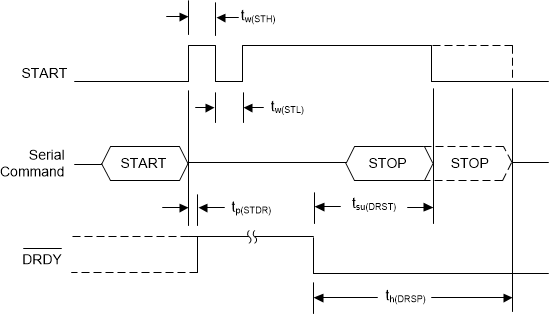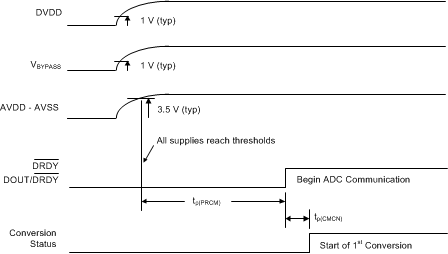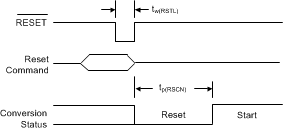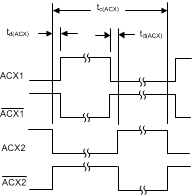SBAS970 October 2019 ADS1235-Q1
PRODUCTION DATA.
- 1 Features
- 2 Applications
- 3 Description
- 4 Revision History
- 5 Pin Configuration and Functions
- 6 Specifications
- 7 Parameter Measurement Information
-
8 Detailed Description
- 8.1 Overview
- 8.2 Functional Block Diagram
- 8.3 Feature Description
- 8.4
Device Functional Modes
- 8.4.1 Conversion Control
- 8.4.2 Chop Mode
- 8.4.3 AC-Bridge Excitation Mode
- 8.4.4 ADC Clock Mode
- 8.4.5 Power-Down Mode
- 8.4.6 Reset
- 8.4.7 Calibration
- 8.5 Programming
- 8.6
Register Map
- 8.6.1 Device Identification (ID) Register (address = 00h) [reset = Cxh]
- 8.6.2 Device Status (STATUS) Register (address = 01h) [reset = 01h]
- 8.6.3 Mode 0 (MODE0) Register (address = 02h) [reset = 24h]
- 8.6.4 Mode 1 (MODE1) Register (address = 03h) [reset = 01h]
- 8.6.5 Mode 2 (MODE2) Register (address = 04h) [reset = 00h]
- 8.6.6 Mode 3 (MODE3) Register (address = 05h) [reset = 00h]
- 8.6.7 Reference Configuration (REF) Register (address = 06h) [reset = 05h]
- 8.6.8 Offset Calibration (OFCALx) Registers (address = 07h, 08h, 09h) [reset = 00h, 00h, 00h]
- 8.6.9 Full-Scale Calibration (FSCALx) Registers (address = 0Ah, 0Bh, 0Ch) [reset = 00h, 00h, 40h]
- 8.6.10 Reserved (RESERVED) Register (address = 0Dh) [reset = FFh]
- 8.6.11 Reserved (RESERVED) Register (address = 0Eh) [reset = 00h]
- 8.6.12 Reserved (RESERVED) Register (address = 0Fh) [reset = 00h]
- 8.6.13 PGA Configuration (PGA) Register (address = 10h) [reset = 00h]
- 8.6.14 Input Multiplexer (INPMUX) Register (address = 11h) [reset = FFh]
- 9 Application and Implementation
- 10Power Supply Recommendations
- 11Layout
- 12Device and Documentation Support
- 13Mechanical, Packaging, and Orderable Information
Package Options
Mechanical Data (Package|Pins)
- RHM|32
Thermal pad, mechanical data (Package|Pins)
- RHM|32
Orderable Information
6.7 Switching Characteristics
over operating ambient temperature range, DVDD = 2.7 V to 5.25 V, and DOUT/DRDY load: 20 pF || 100 kΩ to DGND (unless otherwise noted)| PARAMETER | MIN | TYP | MAX | UNIT | |
|---|---|---|---|---|---|
| SERIAL INTERFACE | |||||
| tw(DRH) | Pulse duration, DRDY high | 16 | 1/fCLK | ||
| tp(CSDO) | Propagation delay time, CS falling edge to DOUT/DRDY driven | 0 | 50 | ns | |
| tp(SCDO1) | Propagation delay time, SCLK rising edge to valid DOUT/DRDY | 40 | ns | ||
| th(SCDO1) | Hold time, SCLK rising edge to invalid data on DOUT/DRDY | 0 | ns | ||
| th(SCDO2) | Hold time, last SCLK falling edge of operation to invalid data on DOUT/DRDY | 15 | ns | ||
| tp(SCDO2) | Propagation delay time, last SCLK falling edge to valid data ready function on DOUT/DRDY | 110 | ns | ||
| tp(CSDOZ) | Propagation delay time, CS rising edge to DOUT/DRDY high impedance | 50 | ns | ||
| RESET | |||||
| tp(RSCN) | Propagation delay time, RESET rising edge or RESET command to start of conversion | 512 | 1/fCLK | ||
| tp(PRCM) | Propagation delay time, power-on threshold voltage to ADC communication | 216 | 1/fCLK | ||
| tp(CMCN) | Propagation delay time, ADC communication to conversion start | 512 | 1/fCLK | ||
| AC EXCITATION | |||||
| td(ACX) | Delay time, phase-to-phase blanking period | 8 | 1/fCLK | ||
| tc(ACX) | ACX period | 2 | tSTDR | ||
| CONVERSION CONTROL | |||||
| tp(STDR) | Propagation delay time, START high or START command to DRDY high | 2 | 1/fCLK | ||
 Figure 1. Serial Interface Timing Requirements
Figure 1. Serial Interface Timing Requirements  Figure 2. Serial Interface Switching Characteristics
Figure 2. Serial Interface Switching Characteristics  Figure 3. Serial Interface Auto-Reset Characteristics
Figure 3. Serial Interface Auto-Reset Characteristics  Figure 4. Conversion Control Timing Requirements
Figure 4. Conversion Control Timing Requirements  Figure 5. Power-Up Characteristics
Figure 5. Power-Up Characteristics  Figure 6. RESET pin and RESET Command Timing Requirements
Figure 6. RESET pin and RESET Command Timing Requirements  Figure 7. AC-Excitation Switching Characteristics
Figure 7. AC-Excitation Switching Characteristics  Figure 8. Timing Voltage-Level Reference
Figure 8. Timing Voltage-Level Reference